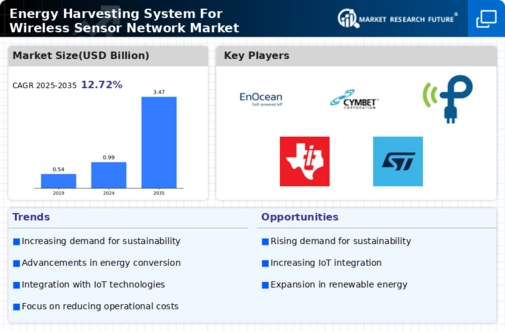Market Growth Projections
The Global Energy Harvesting System For Wireless Sensor Network Market Industry is projected to grow significantly over the next decade. The market is expected to expand from 0.99 USD Billion in 2024 to 3.47 USD Billion by 2035, reflecting a CAGR of 12.08% from 2025 to 2035. This growth trajectory indicates a strong demand for energy harvesting solutions, driven by advancements in technology, increasing adoption of IoT devices, and the need for sustainable energy sources. The market's expansion is likely to create new opportunities for innovation and investment in energy harvesting technologies.
Advancements in Technology
Technological advancements play a crucial role in the Global Energy Harvesting System For Wireless Sensor Network Market Industry. Innovations in materials and energy conversion technologies enhance the efficiency and effectiveness of energy harvesting systems. For instance, the development of piezoelectric materials and improved photovoltaic cells has led to more efficient energy capture from ambient sources. These advancements not only increase the reliability of wireless sensor networks but also contribute to their widespread adoption across various sectors, including agriculture, healthcare, and smart cities, thereby driving market growth.
Need for Continuous Monitoring
The necessity for continuous monitoring in various applications, such as environmental monitoring and industrial automation, propels the Global Energy Harvesting System For Wireless Sensor Network Market Industry. Organizations increasingly require real-time data to make informed decisions, leading to a surge in demand for wireless sensor networks powered by energy harvesting systems. These systems provide a reliable power source, ensuring uninterrupted operation and data transmission. As industries recognize the value of continuous monitoring for efficiency and safety, the adoption of energy harvesting technologies is expected to rise, further driving market growth.
Rising Adoption of IoT Devices
The increasing proliferation of Internet of Things (IoT) devices is a key driver of the Global Energy Harvesting System For Wireless Sensor Network Market Industry. As IoT applications expand across various sectors, the demand for energy-efficient and self-sustaining devices rises. Energy harvesting systems enable these devices to operate without the need for frequent battery replacements, thus enhancing their longevity and reducing maintenance costs. This trend is particularly evident in smart home technologies and industrial automation, where energy harvesting solutions are becoming integral to the functionality of wireless sensor networks.
Government Initiatives and Regulations
Government initiatives and regulations aimed at promoting energy efficiency and sustainability significantly influence the Global Energy Harvesting System For Wireless Sensor Network Market Industry. Many governments are implementing policies that encourage the adoption of renewable energy technologies, providing incentives for businesses to invest in energy harvesting solutions. For example, tax credits and grants for renewable energy projects are becoming more common, fostering an environment conducive to market expansion. These regulatory frameworks not only support innovation but also create a favorable landscape for the growth of energy harvesting systems in wireless sensor networks.
Growing Demand for Sustainable Solutions
The Global Energy Harvesting System For Wireless Sensor Network Market Industry is witnessing an increasing demand for sustainable energy solutions. As industries and consumers become more environmentally conscious, there is a notable shift towards renewable energy sources. This trend is reflected in the projected market growth from 0.99 USD Billion in 2024 to an estimated 3.47 USD Billion by 2035, indicating a robust compound annual growth rate (CAGR) of 12.08% from 2025 to 2035. This growth is driven by the need for energy-efficient systems that minimize carbon footprints while maintaining operational efficiency.
















